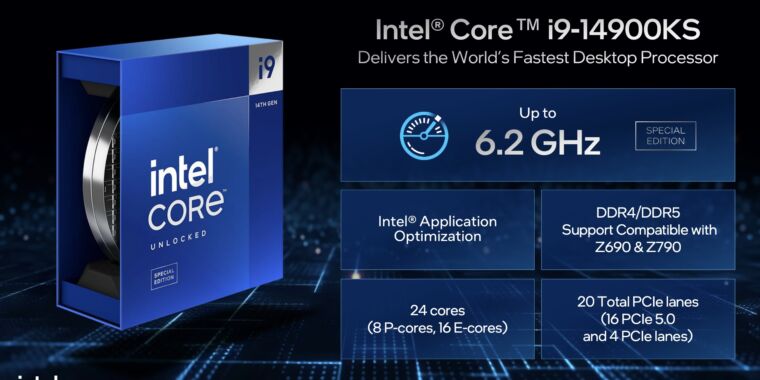Intel’s New Core i9-14900KS Processor
Back in the ’90s and early 2000s, Intel made headlines with its ever-increasing clock speeds as the primary metric for enhancing processor performance. While AMD also joined the race and hit 1 GHz before Intel, the Pentium 4 processors from Intel focused on boosting clock speeds at the expense of instructions-per-clock. Fast forward to today, and Intel is revisiting those glory days with its latest flagship desktop processor, the Core i9-14900KS, priced at $689. This new processor can achieve speeds of up to 6.2 GHz—slightly higher than its predecessors, the i9-13900KS and i9-14900K, which topped out at 6.0 GHz. Additionally, it features Intel’s Adaptive Boost Technology, allowing the chip to ramp up power consumption and performance until it reaches 100° Celsius.
This impressive boost in clock speeds is a testament to Intel’s continuous innovation and refinement across multiple processor generations. However, the practicality of such high clock speeds comes into question due to the significant power consumption required to achieve marginal performance gains. The i9-14900KS comes with a TDP of 320 W, notably higher than the 253 W TDP of the i9-14900K. While manufacturers often disregard Intel’s specified TDP levels, choosing to operate CPUs at virtually unlimited TDPs and relying on thermal throttling for protection, real-world tests reveal substantial power consumption disparities with minimal performance improvements.
For instance, benchmarks conducted by Tom’s Hardware show that in a Blender rendering test, the i9-14900KS consumed 31 percent more power than its predecessor for less than a 1 percent performance boost. While variations exist in different scenarios, the overall trend indicates that the power consumption increase surpasses the performance enhancements.
These high-performance processors designed primarily for boasting rights are likely to persist in the market. However, Intel’s Core i9 lineup, including the 14th-gen processors, the LGA 1700 socket, and the Raptor Lake architecture, may see the end of their era soon. While Intel has a history of rebranding and repurposing older silicon for new product launches, rumors circulating suggest that the upcoming LGA 1851 socket and the “Arrow Lake” processors could take the mantle as Intel’s flagship desktop platform in the coming year.
References:
- AMD 1 GHz First
- Intel Adaptive Boost Technology
- Tom’s Hardware Review
- Intel LGA 1851 “Arrow Lake” Socket
Image/Photo credit: source url





